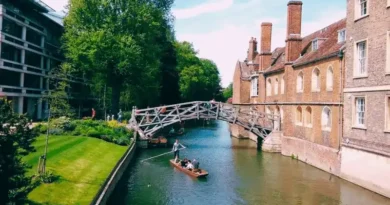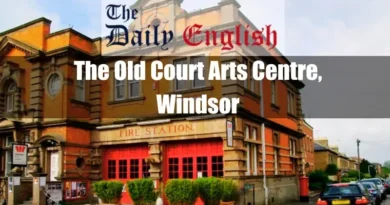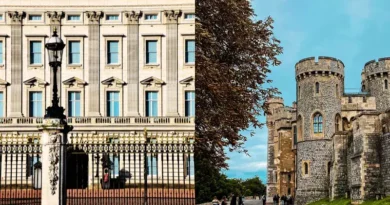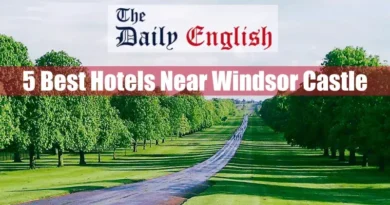How Big is Windsor Castle Estate?
Windsor Castle is part of a much larger estate that includes several different areas and properties. The castle itself covers approximately 13 acres (5.3 hectares) within its walls. However, the total area of the Windsor estate, which includes Windsor Great Park, Frogmore Estate, and various other properties, spans about 15,800 acres (6,400 hectares). The estate also includes formal gardens, parklands, and agricultural land, with Windsor Great Park alone covering around 5,000 acres (2,020 hectares).
These vast lands have been gradually accumulated over centuries, reflecting the castle’s long history and its continuous use as a royal residence. The estate is a mix of private royal areas and public spaces managed by the Crown Estate and other royal trusts.
Detailed Breakdown of Windsor Castle Estate:
Here’s a table summarizing the measurements of different areas within the Windsor Castle estate, along with a total calculation:
| Area | Size | Description |
|---|---|---|
| Windsor Castle Grounds | 13 acres (5.3 hectares) | The area within the castle walls, including the main structures, courtyards, and gardens. |
| Windsor Great Park | 5,000 acres (2,020 hectares) | A large park surrounding Windsor Castle, including deer parks, woodlands, and formal gardens. |
| Home Park | 655 acres (265 hectares) | Adjacent to Windsor Castle, containing gardens, a royal farm, and additional residences. |
| Frogmore Estate | Part of Windsor Home Park | Includes Frogmore House, Frogmore Cottage, and the Royal Mausoleum within the boundaries of Home Park. |
| Windsor Estate Total | 15,800 acres (6,400 hectares) | The total area of Windsor Castle’s estate, including all parks, gardens, and associated properties. |
| The Long Walk | 2.65 miles (4.26 kilometres) | A tree-lined avenue stretching from Windsor Castle to the Copper Horse statue. |
Total Acreage:
Windsor Castle Grounds + Windsor Great Park + Home Park = 5,668 acres (13 acres + 5,000 acres + 655 acres)
Excluding the Frogmore Estate since it’s part of Home Park.
Total Hectares:
Windsor Castle Grounds + Windsor Great Park + Home Park = 2,290.3 hectares (5.3 hectares + 2,020 hectares + 265 hectares)
Again, we exclude Frogmore Estate for the same reason.
This calculation gives a clear overview of the significant portions of the Windsor Castle estate. The total area, considering the main components (excluding subdivisions like Frogmore that are counted within Home Park), is approximately 5,668 acres (2,290.3 hectares).
1. Windsor Castle Grounds:
The core of Windsor Castle is set within 13 acres of land. The castle complex itself functions as a fortification, palace, and small town, housing various facilities and historical structures, including the iconic Round Tower and St. George’s Chapel.
2. Frogmore Estate and Other Areas:
The Frogmore Estate, part of Windsor’s Home Park, includes additional gardens and royal residences such as Frogmore House and Frogmore Cottage. The estate’s significance is bolstered by its historical use by the royal family and its picturesque landscapes.
3. The Long Walk:

One of the most famous features of the Windsor estate is the Long Walk, which stretches southward from Windsor Castle towards the Copper Horse statue. The Long Walk itself is approximately 2.65 miles (4.26 kilometres) long. This impressive tree-lined avenue was initially laid out by King Charles II in the late 17th century, providing a dramatic approach to the castle.
4. Windsor Great Park:
Windsor Great Park, the largest portion of the estate, extends over 5,000 acres (2,020 hectares). The park includes various attractions such as the Savill Garden, Valley Gardens, and Virginia Water Lake, all of which contribute to the estate’s overall length and breadth.
5. Home Park:
Adjacent to the castle, Home Park covers around 655 acres (265 hectares). This area is more intimately connected to the castle, containing gardens, a royal farm, and additional residences like Frogmore House.
6. Other Notable Structures and Features:
The entire Windsor estate includes multiple residences, historic buildings, and gardens. Key areas like Frogmore Gardens and the Royal Lodge add to the estate’s expanse, with paths and roads linking these areas across the landscape.
Historical Context and Management:
Windsor Castle was established in the late 11th century by William the Conqueror and has since been continuously occupied, making it the longest-occupied palace in Europe. Over centuries, the estate has expanded to include various gardens, parklands, and agricultural lands, reflecting its evolving role from a fortress to a royal residence and tourist attraction.
The estate is managed by various entities, including the Crown Estate, which oversees Windsor Great Park. At the same time, the Royal Household maintains the castle itself.
Insights
- Strategic and Aesthetic Design: The length and overall layout of Windsor Castle’s estate are both strategic and aesthetic. The Long Walk, for example, not only serves as a grand approach but also offers sweeping views of the castle and its surrounding countryside. This meticulous design reflects the estate’s importance in royal ceremonies and its role as a symbol of the monarchy.
- Public Accessibility: While much of the estate remains private, large portions of it, particularly Windsor Great Park, are accessible to the public. This allows visitors to experience the scale and beauty of the estate firsthand, contributing to its status as a significant cultural and tourist destination.
Importance of the Estate
Windsor Castle’s estate is not only significant due to its size but also because of its historical, cultural, and architectural importance. The vast lands provide a mix of public and private spaces that continue to be used by the British royal family for state events, private residences, and as a public attraction. The management of these lands ensures the preservation of the natural landscape, historical buildings, and the continued heritage of the British monarchy.
Conclusion
Windsor Castle and its extensive estate represent a unique combination of historical architecture, royal tradition, and natural beauty. Spanning over 15,800 acres, it is one of the world’s largest and most significant royal estates, serving as both a private royal residence and a public landmark. The estate’s management carefully balances conservation and public accessibility, ensuring that its rich heritage is preserved for future generations.
FAQ
What is the total area of Windsor Castle?
Windsor Castle occupies approximately 13 acres (5 hectares) of land, encompassing a complex of buildings, courtyards, and gardens. This area includes the Upper, Middle, and Lower Ward, each serving distinct functions within the Castle’s layout.
How large is the Windsor Estate?
The Windsor Estate spans about 6,400 hectares (15,800 acres), incorporating Windsor Great Park, Home Park, and Swinley Forest. This vast area features a mix of parkland, gardens, woodlands, and agricultural land, reflecting centuries of landscape development.
What is the floor area of Windsor Castle?
The Castle’s floor area is approximately 54,835 square metres (around 590,239 square feet), making it one of the largest inhabited castles globally. This extensive space includes over 1,000 rooms, such as state apartments, private chambers, and service areas.
How many rooms does Windsor Castle have?
Windsor Castle boasts over 1,000 rooms, including grand state apartments used for official events, private royal family quarters, and accommodations for staff. The diversity of rooms reflects the Castle’s multifaceted role as a royal residence, administrative hub, and historical monument.
What is the height of the Round Tower at Windsor Castle?
The Round Tower stands approximately 65.5 feet (20 metres) tall, situated atop an artificial motte that elevates it further. This central feature provides panoramic views of the surrounding landscape and has historically served as a defensive stronghold.
How long is the Long Walk in Windsor Great Park?
The Long Walk extends about 2.64 miles (4.25 kilometres) from Windsor Castle to the Copper Horse statue. This tree-lined avenue, established during the reign of Charles II, offers iconic views of the Castle and is a popular route for visitors and royal processions.
What is the size of the State Apartments in Windsor Castle?
The State Apartments occupy most of the Upper Ward, featuring grand rooms designed for official ceremonies and receptions. These opulent spaces showcase an extensive art collection, including works by Rembrandt and Rubens, and are adorned with exquisite furnishings.
How extensive are the gardens within Windsor Castle?
The Castle’s gardens encompass several acres, with the East Terrace Garden alone spanning approximately 3 acres (1.2 hectares). These meticulously maintained gardens feature formal landscaping and vibrant flowerbeds, providing a serene setting adjacent to the historic architecture.
What is the size of St George’s Chapel within Windsor Castle?
St George’s Chapel measures about 72 metres (236 feet) in length and serves as a prime example of English Gothic architecture. As the spiritual home of the Order of the Garter, it has hosted numerous royal ceremonies, including weddings and funerals.
How many fireplaces are there in Windsor Castle?
The Castle contains over 300 fireplaces, each integral to heating the vast rooms and corridors. These fireplaces range from grand ornamental pieces in the state apartments to functional hearths in service areas, reflecting the Castle’s historical reliance on open fires for warmth.
What is the size of the Quadrangle at Windsor Castle?
The Quadrangle, located in the Upper Ward, is a central courtyard surrounded by the State Apartments and private royal quarters. This expansive open space is often used for ceremonial events and provides a grand approach to the Castle’s primary rooms.
How large is the Home Park adjacent to Windsor Castle?
Home Park covers approximately 655 acres (265 hectares), including private gardens, parkland, and a deer park. This area serves as a private recreational space for the royal family and hosts events like the annual Royal Windsor Horse Show.
What is the area of the East Terrace Garden at Windsor Castle?
The East Terrace Garden spans about 3 acres (1.2 hectares) and features formal landscaping with manicured lawns, flowerbeds, and a central fountain. Originally laid out in the 1820s, it has been modified over the years and is occasionally opened to the public.
How many towers does Windsor Castle have?
Windsor Castle features several towers, with the Round Tower being the most prominent. Other notable towers include the Edward III Tower, Henry III Tower, and the Winchester Tower, each contributing to the Castle’s fortified appearance and historical defense mechanisms.
What is the size of the Waterloo Chamber in Windsor Castle?
The Waterloo Chamber is a grand room measuring approximately 30 metres (98 feet) in length. Commissioned by George IV, it commemorates the defeat of Napoleon at the Battle of Waterloo and is adorned with portraits of key figures from the era.
How extensive is the Windsor Great Park?
Windsor Great Park covers about 5,000 acres (2,020 hectares) of parkland, gardens, and woodland. Once a royal hunting ground, it now offers public access to its scenic landscapes, including features like the Savill Garden and Virginia Water Lake.
What are the dimensions of the motte beneath the Round Tower?
The motte—the mound on which the Round Tower stands—is a significant structure, measuring almost 246 feet (75 meters) in diameter at its base and 43 feet (13 meters) in height.









